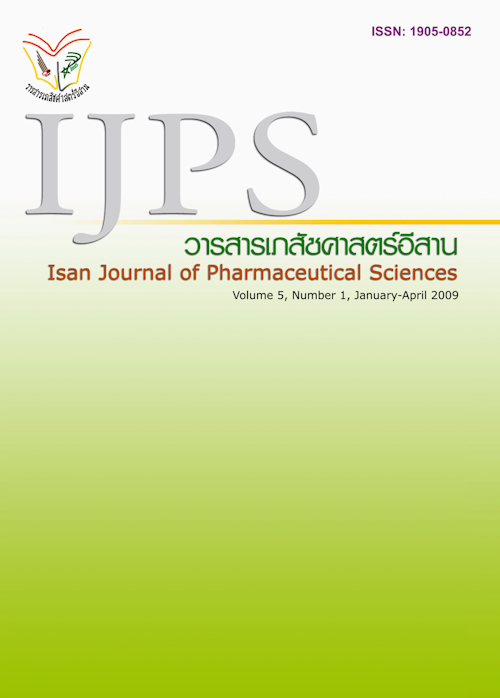Anticancer Protein from Bitter Melon Cultivated in Thailand
Main Article Content
Abstract
Protein extraction from bitter melon (Momordica charantia L.) cultivated in Thailand composed of amount of different proteins. The major protein was 30 kDa in size. For this study, we purified the proteins by using Resource S (ion exchange column) and following by Superdex 200 HR10/30 (gel filtration) equipped with an FPLC apparatus. They were glycoproteins with Isoelectric point (pI) > 8.4 and molecular weights of approximately 30 kDa. Both possessed potent anticancer activity against L929 (mouse fibroblasts) at the IC₅₀ of 1.7 µg/ml possibly via apoptotic pathways determined by DNA fragmentation and cells’ morphology change methods.
Article Details
In the case that some parts are used by others The author must Confirm that obtaining permission to use some of the original authors. And must attach evidence That the permission has been included
References
Ahmed I, Lakhani MS, Gillett M, et al. Hypotriglyceridemic and hypocholesterolemic effects of anti-diabetic Momordica charantia (Karela) fruitextract in streptozotocin-induced diabetic rats. Diabetes Res. Clin. Pract 2001; 51(3): p.155-161.
Barbieri L, Battelli MG, Stripe F. Ribosome-inactivating proteins from plants. Biochemicaet Biophysica Acta 1993; 1154: p.237-282.
Battelli MG, Polito L, Bolognesi A, et al. Toxicity of ribosome-inactivating proteins-containing immunotoxins to a human bladder carcinomacell line. Int J Cancer 1996; 65(4): p.485-490.
Bourinbaiar AS, Lee-Huang S. The activity of plant-derived antiretroviral proteins MAP30and GAP31 against herpes simplex virus invitro. Biochem Biophys Res Commun 1996;219(3): p.923-929.
Bolognesi A, Tazzari PL, Olivieri F, et al. Induction of apoptosis by ribosome-inactivating proteins and related immunotoxins. Int J Cancer 1996; 68(3): p.349-355.
Cadot Y, Miñana-Castelló MT, Chevalier M. Anatomical, histological, and histochemical changes in grape seeds from Vitis vinifera L. cv Cabernet franc during fruit development. J Agric Food Chem 2006; 54(24): p.9206-9215.
Chaturvedi P, George S, Milinganyo M, et al. Effect of Momordica charantia on lipid profile and oral glucose tolerance in diabetic rats. Phytother Res 2004; 18(11): p.954-956.
Dengiz GO, Gursan N. Effects of Momordica charantia L. (Cucurbitaceae) on indomethacin-inducedulcer model in rats. Turk J Gastroenterol 2005;16(2): p.85-88.
Fong WP, Poon YT, Wong TM, et al. A highly efficient procedure for purifying the ribosome-inactivating proteins α- and β-momorcharinsfrom Momordica charantia seeds, N-terminal sequence comparison and establishing of their N-glycosidase activity. Life Sci 1996;59(11): p.901-909.
Hwang YYH, Lee JJW, Hahm EER, et al. Momordin I, an inhibitor of AP-1, suppressedosteoclastogenesis through inhibition of NF-kappa B and AP-1 and also reduced osteoclast activity and survival. Biochem Biophys Res Commun 2005; 337(3): p.815-823.
Jerome KR, Chen Z. Apoptosis in HL-60 Cells and Topoisomerase I In Vivo. Archi Patho Lab Med2000; 124(6): p.802-803.
Kim JB, Ko E, Han W, et al. Berberine diminishes the side population and ABCG2 transporter expression in MCF-7 breast cancer cells. Planta Med 2008; 74(14): p.1693-1700.
Kim JH, Ju EM, Lee DK, et al. Induction of apoptosisby momordin I in promyelocytic leukemia(HL-60) cells. Anticancer Res 2002; 22(3): p.1885-1889.
Lee-Huang S, Huang PL, Chen HC, et al. Anti-HIV and anti-tumor activities of recombinantMAP30 from bitter melon. Gene 1995; p.151-156.
Lopez L, Villavicencio MA, Albores A, et al. Cupressus Lusitanica (Cupressaceae) leaf extract inducesapoptosis in cancer cells. J Ethnopharmacol2004; 80(2-3): p.115-120.
Meshkini A, Yazdanparast R, Haidari M. Differentiationand Apoptosis of U-937 Leukemia Cells byan Active Compound from Dendrostelleralessertii. Iran Biomed J 2009; 13(1): p.35-42.
Mosmann T. Rapid colorimetric assay for cellular growth and survival: Application to proliferation and cytotoxicity assays. J Immunol Methods1983; 65: p.55-63.
Mullauer FB, Kessler JH, Medema JP. Betulinic acidinduces cytochrome c release and apoptosisin a Bax/Bak-independent, permeability transition pore dependent fashion. Apoptosis2009; 14(2): p.191-202.
Nadova S, Miadokova E, Alfoldiova L, et al. Potentialantioxidant activity, cytotoxic and apoptosis-inducing effects of Chelidonium majus L.
extract on leukemia cells. Neuro Endocrinol Lett2008; 29(5): p.649-652.
Nielsen K, Boston RS. Ribosome-inactivating protein: A plants perspective. Annu Rev Plant Physiol Plant Mol Biol 2001; 52: p.785-816.
Nishimura R, Tabata K, Arakawa M, et al. Isobavachalcone, a chalcone constituent of Angelica keiskei, induces apoptosis inneuroblastoma. Biol Pharm Bull 2007;30(10): p.1878-1883.
Ng TB, Liu WK, Sze SF, et al. Action of alpha-momorcharin, a ribosome inactivating protein, on cultured tumor cell lines. Gen-Pharmacol1994; 25(1): p.75-77.
Ou L, Kong LY, Zhang XM, et al. Oxidation of Ferulic Acid by Momordica charantia Peroxidase and Related Anti-inflammation Activity Changes. Biol Pharm Bull 2003; 26, p.1511-1516.
Parkash A, Ng TB, Tso WW. Purification and characterization of charantin, a napin-likeribosome-inactivating peptide from bitter gourd (Momordica charantia) seeds. J Peptide Res2002; 59: p.197-202.
Pu Z, Lu BY, Liu WY, et al. Characterization of the enzymatic mechanism of gamma-momorcharin, a novel ribosome-inactivatingprotein with lower molecular weight of 11,500 purified from the seeds of bitter gourd (Momordica charantia). Biochem-Biophys-Res-Commun 1996; 229(1): p.287-294.
Tavakkol-Afshari J, Brook A, Mousavi SH. Study of cytotoxic and apoptogenic properties of saffron extract in human cancer cell lines. Food Chem Toxicol 2008; 46(11): p.3443-3447.
Tse PMF, Ng TB, Fong WP, et al. New ribosome-inactivating proteins from seeds and fruits of the bitter gourd Momordica charantia. Int JBiochem Cell Biol 1999; 31: 895-901.
Wang H, Ng TB. Ribosome inactivating protein and lectin from bitter melon (Momordica charantia) seeds: sequence comparison with relatedproteins. Biochem Biophys Res Commun.1998; 253(1): p.143-146.
Wu CA, Yang YW. Induction of cell death by saponin and antigen delivery. Pharm Res 2004;21(2): p.271-277.
Xiao Y, Yang FQ, Li SP, et al. Essential oil of Curcuma wenyujin induces apoptosis inhuman hepatoma cells. World J Gastroenterol2008; 14(27): p.4309-4318.
Yang ZG, Sun HX, Ye YP. 2006. Ginsenoside Rdfrom Panax notoginseng is cytotoxic towards HeLa cancer cells and induces apoptosis. Chem Biodivers 3(2): p.187-197.
Yoshinobu K, Yuji M, Toshihiko T, et al. 1991; Primary Structures of N-Linked Oligosaccharides of Momordin-a, a Ribosome-inactivating Proteinfrom Momordica charantia Seeds (Biological Chemistry). Agricultural and Biological Chemistry 55(8): p.2031-2036.
Zhang Q, Wu J, Hu Z, et al. 2004. Induction of HL-60 apoptosis by ethyl acetate extract of Cordyceps sinesis fungal mycelium. Life Sci75: p.2911-2919.


